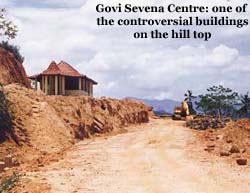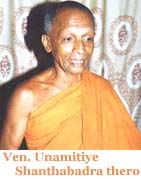 |
 17th May 1998 |
Front Page| |
The nightmare of living close to AmbuluwawaBy Dilrukshi HandunnettiTwo months ago the sleepy village of Sinhapitiya in Gampola was rudely woken by the boom of dynamite and rocks crashing down the hillside, threatening its very existence. The cause: a development project on the Ambuluwawa peak where roads and buildings are being constructed without the required Environment Impact Assessment that is mandatory when building in a sensitive area.
The Environmental Foundation Ltd has already challenged the project’s validity in a letter of demand to the Central Environmental Authority (CEA) on the grounds that the project contravenes the Soil Conservation Act. No one believed that the Ambuluwawa hill would ever become the site for an international conference hall for it had been declared an erodable area under the Soil Conservation Act since 1960. People in their simple faith believed that it was a risk that none would take in an area often subjected to earthslips. But that was not to be. Standing 3565 feet above sea level, the Ambuluwawa hill demarcates the Kegalle and Kandy administrative districts. Gampola became the capital in 1344 AD owing to the natural protection it afforded. The epic Mayura Sandeshaya in glowing terms praised the beauty of this historic and ecologically important hill. The hill derived its name from the natural waterways which sprung from various areas of the rocky hill top, amba meaning water and ulu meaning springs. It is also believed the hill was so named to mean Nelli tree forest. Excavations have led to the discovery of many items of archaeological importance in Ambuluwawa, including two Gaja Sinha Rupa (massive lion structures), hence the name Sinhapitiya for the village at the foot of the hill. It was here, the first coffee sapling was planted by the British. But things have changed drastically since, with constant wild fires and illicit felling of trees contributing to the fast depleting forest cover. Ambuluwawa today is threatened by landslides, and in 1960, the then Minister C.P. de Silva declared this an erodable area. Later, the entire Central Province due to its natural waterways and rich bio-diversity was declared a sensitive area. In November 1997, Minister of Agriculture and Lands D.M. Jayaratne through a Cabinet proposal sought to develop Ambuluwawa and surrounding villages. Before the proposal was through, construction began on April 3rd, 1997. When The Sunday Times visited Ambuluwawa, construction work had come to a temporary halt with the slight drizzle aggravating the risk of earthslips. The journey to the hill top was arduous, with dust rising from the newly built road, the edges of which were getting washed away. The slopes were so cracked, a slip of one’s foot have ensured a meeting with the maker. According to Sumathipala, occupant of a thatched house, people live in perpetual fear. “It is a nightmare for us living close to Ambuluwawa. During the day, dynamite is used at least twenty times causing severe vibrations. We dread the rains and the ensuing consequences,” he said. On the hilltop, a Govi Sevana Centre has been built, while further up was the imposing building -the cause of the controversy. All the while, bulldozers were being used, and brick and cement laden tractors went up and down. There were many surprises in store for us. A group of six people prevented us from climbing upwards to view the Japanese funded Sama Chaitya site, claiming entry and photography were prohibited. A Doluwa Govi Sanvidhanaya member said that a police post was set up to prevent the ‘unsavoury’ visits, adding that the previous day, policemen had the pleasure of smashing two cameras of university students. When we explained that Ambuluwawa was not a strict reserve requiring permission to photograph, he added that political opponents were spreading falsehoods, hence the prohibition. At the foot of the hill parents and children had a different story. Sama is seven years old, and she was playing with her twin brother when she heard a loud crashing noise. Unable to comprehend that dynamite was being used to blow the Ambuluwawa hill, they ran homewards. But the fears never subsided as the dynamite use increased over the days. The children cannot roam the jungles anymore, and their homes are no longer safe. Their mother Sandhya is furious that their ancestral property was being made uninhabitable by callous authorities. “Suddenly this project was thrust upon us. What we are unable to comprehend is as to why they needed to render us homeless, ignoring our pleas,” she said vehemently, adding that they had nowhere else to go. Mr. D. Ayuwardene, a retired Assistant Commissioner of Co-operatives has repeatedly lodged complaints at the Gampola police station to no avail We were not informed of the project nor of dynamite use,” he said, showing the cracked walls of his home. Having sought a peaceful retired life, Ayuwardene’s dreams have been shattered today.
“There are about 35 families at the foot of the hill, and part of the land is Sanghika property. The whole project is politically motivated and illegal,” he charged, indicating a deed of transfer by one Ukku Amma. The residents ask as to why some other area, closer to the town and with better infrastructure to develop a conference hall was not chosen. Banker Nimal Rathnayake, who has conducted research on the Ambuluwawa area has protested to the CEA, but received no reply. As relocation would not be considered, Nimal seeks an assurance from the authorities that they would minimize destruction and maximum safeguards. Sanjeewa Kaviratne, “Dumbara Surakinno” member and Central Provincial Councillor said that an international conference hall in the midst of a village was laughable. “The authorities have blatantly violated procedures. Construction commenced sans the EIA, and government resources are used for the project. Though construction in an erodable area is prohibited, a permit has been issued, and work began long before authorization was issued,” he charged. A leading environmental lawyer said that an EIA was mandatory when building in an erodable area. Any project exceeding one hectare of land in a sensitive area became a prescribed project requiring an EIA. Being the ultimate authority to withdraw, revoke and withhold permission for a project, the CEA was thereafter required to consider the merits and demerits, and to propose alternatives. CEA Chairman Lionel Jayasinghe said that he was unable to say offhand whether the particular project required an EIA, adding that the project was initiated by a responsible Cabinet Minister, and the CEA had nothing to state beyond the Minister’s statement in Parliament. Herpetologist Dr. Anslem de Silva however defends the choice of location. Despite the negative publicity, it was suitable for a reptile park, for which he has submitted a project report, he said. Director, Wild Life Conservation Department Berty Jayasekera said that aviaries and butterfly parks required Departmental sanction, even for research purposes. As these parks were mostly for recreation purposes, they certainly needed prior approval for the specific project, which the Department has not granted yet. Refuting all charges Chairman of the Gampola UC S.P. Wittachchi said that the protests were inspired by a political rival opposed to the development of a backward area. The private land of 846/1164 were to be acquired including the Dharmashrama land under public purpose, and the project would do much good. 250 acres are being reforested, but political opponents are trying to score petty points,” he said.
Bio diversity of Ambuluwawa.The Ambuluwawa hill which originally possessed over 80% of forest cover has little left. First cleared in colonial times to establish tea plantations, the forest cover has dwindled to a mere 20% due to illicit felling of trees and forest fires. Ambuluwawa, Hantana, Gonnoruwa and Udawattekele are fields of research which collectively form a veritable paradise for reptiles, birds, lizards and butterflies. The area has the features of a tropical rain forest mingled with interzonal features. Rare medicinal plants like iraraja, wanaraja and sandaraja, kuda hedaya and maha hedaya are found here. Herbs like nelli, rasakinda, iramusu and hora, buhura, na are also found. Loris and sambhur, bodilya, pala katussa, common krait, Russel’s viper, python and many migrant and endemic bird varieties are found in Ambuluwawa. However, out of the 22 waterways recorded here,only six exist today. |
||
 |
More Plus * After thought
Front Page| News/Comment| Editorial/Opinion| Business| Sports | Mirror Magazine |
|
 |
Please send your comments and suggestions on this web site to |
|
 The
ambitious project involves the construction of an international conference
hall, govi sevana centres and a sama chaitya. The salient features of the
project include the setting up of aviaries, butterfly and reptile parks,
and introduction of cable cars.
The
ambitious project involves the construction of an international conference
hall, govi sevana centres and a sama chaitya. The salient features of the
project include the setting up of aviaries, butterfly and reptile parks,
and introduction of cable cars.  Prelate
of the Sinhapitiya Dharmayathanaya, Ven. Unamitiye Shanthabadra Thero has
set up a civilian watch in protest, and plans to seek legal remedies for
building on private land, including that of the temple.
Prelate
of the Sinhapitiya Dharmayathanaya, Ven. Unamitiye Shanthabadra Thero has
set up a civilian watch in protest, and plans to seek legal remedies for
building on private land, including that of the temple.